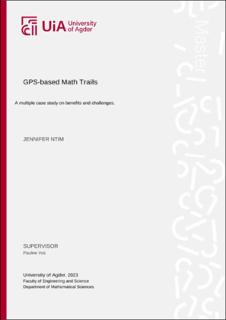| dc.description.abstract | It is an undeniable fact that mathematics contributes tremendously to human activities. However, some students think of mathematics as boring and unrelated to the environment. Some students have expressed how mathematics is not related to the real world. Some dressed-up tasks which are inauthentic are given to the students as word problems to connect mathematics and reality. This study sought to find an alternative activity to these dressed-up tasks. As well as find the challenges and benefits of having such kind of activities.
Research has shown that, having outdoor learning provides for the students to learn in a real and authentic situation. Some educational theories prove that learning in an authentic situation mediates between students’ mathematical knowledge and reality.
Math trail, is an outdoor math activity, in which the participants walk to discover mathematics in the environment. In recent times, math trail activities have been used in schools to supplement mathematics learning. In this study, the math trails activity was blended with modern technology. That is, it was GPS-based. This study sought to find out the benefits and challenges of doing a GPS-based math trail.
Case study and design-based research approaches were employed for the study. Actionbound app was used to design the math trails activity. It had a GPS feature and also a feature which tasks and solutions of tasks could be used. The data were collected from two different groups; 16 first-year videregående students, 10 fourth-year mathematics education teachers, 1 mathematics lecturer and the researcher. Two math trails activities were done namely; the KKG math trail and the pre-service teacher’s math trail. One of the major benefits is that the students saw the connection of some mathematical concepts with real life and one of the challenges was when they didn’t see some of the tasks relating to mathematics but rather, a question whose answer needed to be guessed while having the activity. The GPS-based app helped the participants to find the tasks locations without difficulty. The Actionbound app which contained tasks and some solutions to the tasks gave immediate feedback to the students.
For the implementation of GPS-based math trails in education settings, further research on this topic is recommended. In the end appendices of the instruments used in the data collection, transcripts, and an information letter are provided.
| |
